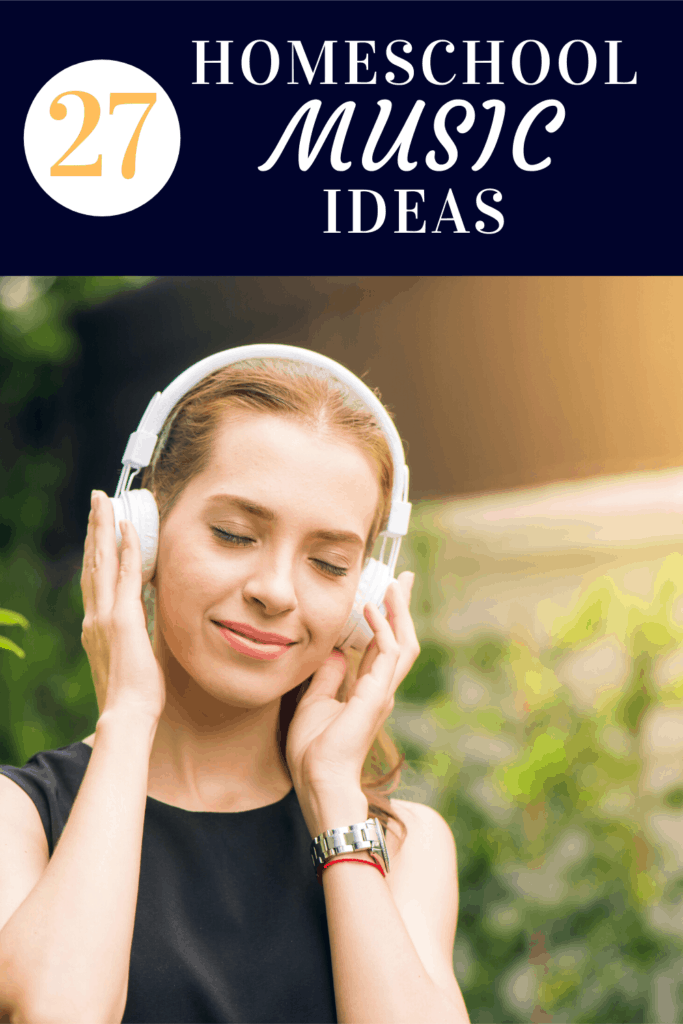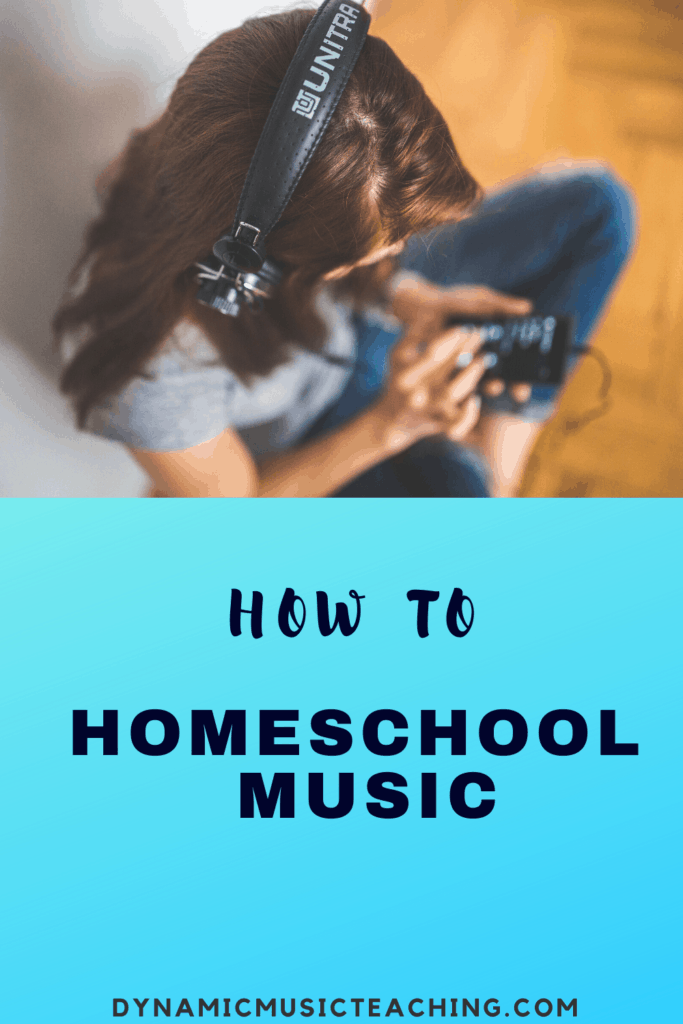Including music education in your homeschool curriculum can seem daunting, especially if you have no background of musical knowledge yourself. It doesn’t have to be that way though! There are lots of easy ways to integrate music learning into your home without having a musical background.

1. Private Music Lessons
Piano lessons are the most popular option, and are widely available in most areas. There is no replacement for learning to play an instrument from a good teacher. Children will learn not just the instrument itself, but develop confidence, self-esteem, and discipline. Many studies suggest an increase in academic performance among children in private music lessons as well. There are many reasons this may not be an option for your family though, such as the cost involved or your location. If your kids are already taking private music lessons, this article has some great ideas to help you support them at home! Read on for more ideas to include music in your homeschool.
2. Group music classes
There are group programs offered in most areas for younger children to learn music appreciation through movement, songs, and simple instruments. These are often more affordable than private lessons, and offer the added benefit of a social activity. Some examples of these classes are Kindermusik, Musikgarten, and Music For Young Children, although there are many others as well.
3. Study Composers
This could be a more in depth unit study for older children, involving research into the composer’s life and musical style. It could also be as simple as learning about different composers by playing the music of a different composer each month. If you’d like to get started with a composer study about J.S. Bach, check out the article here, and the free printable workbook to use with your kids.
4. Music theory
Beginning music theory could include learning note values, musical terms, and to read music. If these are new to you, don’t fear, there are lots of free music theory resources and worksheets online. Learn music theory together with your child!
5. Play music during meals or in the car
These are perfect times to fit in music appreciation. Reflect with your child on what instruments they hear, the tempo of the music, and how it makes them feel.
6. Make an instrument
There are so many options for children to create their own musical instruments! A few ideas are a kazoo, a rainstick, a drum, or maracas and shakers. Once the project is created, experiment with the different sounds the instrument makes, play along freely while listening to music, or make up your own song!
7. Learn to follow a beat
Put on some music with a strong beat such as a march or a children’s song, and clap, march, drum, or tap along with the beat.
8. Use music and songs for transitions
You could play a certain piece of music during the transition from one activity to another, or sing songs during the transition to a new activity. An example of this type of song would be the ‘Clean-Up Song’ that is used in so many childcare centers.
9. Sing
Use songs to teach concepts to younger children. There are simple children’s songs about almost any subject, including songs about counting, colors, animals, months of the year, and days of the week.
10. Join a community music group
Perhaps your community has a band, or music ensemble, or perhaps your church has a children’s choir. You may even be able to participate alongside your child!
11. Dance
Children love to move and feel the music in their bodies. Dance also works great as a short movement break during the school day. Encourage your children to move in time to the music, or in the way that the music makes them feel. You will see your children understand the tempo (fast or slow) of the music, as well as it’s emotions. Another idea is to give your children scarves or ribbons while they are moving freely to the music. Perhaps they can wave them high for high sounds, and low for lower sounds, or quickly during a fast section of the music, and slowly during a slower section.
12. Lapbooks
These are a fun way to make learning more hands on and crafty. Some lapbook ideas for music education could include: a composer such as Beethoven or Chopin, a time period such as Classical or Romantic, a music style such as jazz, or an instrument such as the saxophone, or the evolution of the piano.
13. Movies
Muscials such as The Sound of Music or Mary Poppins (as well as many more modern ones!) are a great way to introduce children to music and encourage singing. There are also many movies about the lives of composers, or musical groups that could be good additions to a musical education.
14. YouTube
Most families aren’t able to attend the symphony, opera, or see live music performances on the regular – I know I can’t! That doesn’t mean you can’t expose your children to all types of music though. Almost everything is available on YouTube these days – from symphonies, to pop music, to children’s nursery songs. Preview to be sure the videos are child appropriate first of course, but do take advantage of this huge library of free music resources!
15. Games
Children love to play, so use games to introduce your children to music notation, musical terms, instruments, or composers! There any many free or affordable music apps that use games to teach music concepts. Printable music board and card games are also lots of fun to teach music concepts! You can learn music through the game along with your children, so long as the game you are playing provides the answers.
16. Explore and Create
Provide your child with a variety of simple musical instruments such as bells, a drum, rhythm sticks, and shakers (most of these can be found in a dollar store, but many could also be created at home if you prefer). Allow your child free play to experiment with different sounds and rhythms.
Encourage your child to create their own song, or if you have multiple children perhaps they can even work together and create their own musical or music video as a larger project!

17. Learn about musical instruments
Learn the instruments of the orchestra together with your child. Identify pictures of them, listen to them in music, talk about what sounds each one makes, or for older children research their history and development. Perhaps go on a field trip to a music store and see them in real life.
18. Learn to play the recorder
There is a reason the recorder is featured prominently in most elementary school music curriculums. There are so many benefits to learning to play an instrument, and the recorder is a very affordable option. Children love to make noise, to create their own music, and to learn to play familiar songs. Even if you cannot remember playing the recorder yourself, you can easily learn the basics along with your child through online resources.
19. Attend live music events
It is wonderful for children to experience music in a live setting frequently. Most communities have inexpensive or free music events going on regularly if you know where to look. Ask at your local library about children’s events. Check with schools, colleges, and universities for choir performances or music recitals. Explore musical events at your local churches. If you live in a larger center, symphonies and operas often have student nights, or invite students to attend a dress rehearsal.
20. Art
Listen to a music recording, and encourage your children to draw what they feel or what the music sounds like to them? Do they feel happy and use bright colors? Do they hear a princess dancing, or a monster jumping out of a cave?
21. Reading
Include music in your reading and language curriculum. You can read stories about composers or musical instruments. Younger children will also enjoy books that include songs they can sing along to.
22. Writing
Include music in your writing curriculum. Ask children to write about a composer, their favorite style of music, or the history of a musical instrument. This is a good followup to reading about these same things!
23. Geography and Social Studies
Music can be integrated into every subject, as you can see! Explore different countries, and other cultures through their music. Listening to music can bring alive a topic for children and spark their interest in learning more about the people who make and enjoy it.
24. History
Music can bring history alive for your children. Listen to the music of the time period you are studying and talk about who would have played it, and in what situations it would be played – is it religious music, is it for dancing, etc.? Learn about the composers living in the time period you are studying. Add them to your book of centuries if you follow the Charlotte Mason approach.
25. Science
Bringing music education into your study of science opens up a lot of opportunities for learning and experimenting for all ages and grade levels of children. Learn about sound waves, frequency, and how sound works. Look for experiments to bring the science of music to life. A simple one to start with is filling multiple glasses with different amounts of water and hearing the different sounds created when tapping each one. Talk about why this happens, and how this affects how some musical instruments sound.
Sing about science! Songs stick in our heads and make it easier to remember concepts, so look for songs about science facts, or create your own, and sing them together!
26. Learn online
This is what you’re doing right now!
There are lots of free and paid resources to help your children learn music online. Use the free printables and resources on this site, and let me know if you have ideas for future resources that would be helpful!
27. Music Apps
No matter what device you have, there are lots of apps available to learn music. Some of my favorite ones include Piano Maestro, Flashnote Derby, and Staff Wars. There are plenty more wonderful music education apps, both free and paid. Let me know which ones you have used!
For more info on the benefits of music in homeschool, see 9 Reasons to Include Music in Homeschool.
Which of these ideas will you try in your homeschool? Do you have even more ways of including music in your home?



